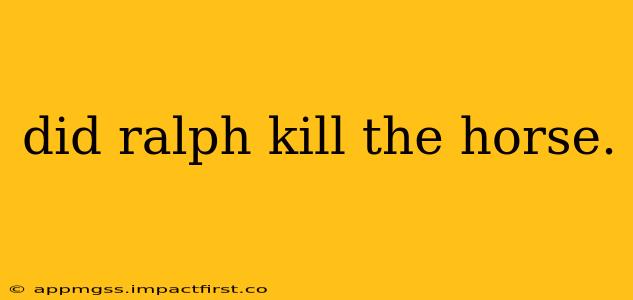The question, "Did Ralph kill the horse?" regarding William Golding's Lord of the Flies, immediately reveals a misunderstanding. There's no horse in Lord of the Flies. The novel focuses on a group of British schoolboys stranded on a deserted island after a plane crash, and their descent into savagery. The narrative revolves around themes of civilization vs. savagery, leadership, and the inherent darkness of human nature. Animals are present, primarily pigs hunted for food by the increasingly brutal Jack and his tribe, but a horse is not among them.
The confusion might stem from a misremembering of the novel, a conflation with another story, or perhaps a misunderstanding of the symbolic significance of the events within Lord of the Flies. The boys' actions, particularly Jack's escalating violence and the symbolic killing of the pig, represent a gradual loss of innocence and the brutalization of their society. This is where the core themes of the book lie, and any discussion of animal deaths needs to be analyzed within that framework.
What Animals Are Killed in Lord of the Flies?
The most significant animal killing in Lord of the Flies involves the pig hunts led by Jack. These hunts are not merely acts of survival; they symbolize the boys' descent into primal savagery. The ritualistic nature of the killings, the escalating violence, and the boys' embrace of paint and tribalistic behavior highlight the abandonment of civilized norms and their descent into brutality.
How Do These Killings Relate to the Theme of Savagery?
The killing of the pigs is pivotal because it marks a turning point in the boys' behavior. Initially, they attempt to maintain order and rescue, but as their hope diminishes and their primal instincts take over, the hunts become increasingly violent and ritualistic. The boys are no longer focused on survival; they are driven by a thirst for power and the thrill of the hunt.
Frequently Asked Questions (Addressing Potential Misunderstandings)
Was there any animal violence in Lord of the Flies besides the pigs?
While the pig hunts dominate the narrative, other acts of violence against animals are present, though less significant. The boys initially hunt for food out of necessity, but the brutality increases as their primal instincts gain control. This escalation is a key aspect of Golding's exploration of human nature.
Are there any misinterpreted aspects of animal symbolism in Lord of the Flies?
The pig itself becomes a potent symbol of savagery and primal urges. Its killing is not simply an act of sustenance but a ritualistic sacrifice that reinforces Jack's power and the boys' descent into chaos. Readers often interpret the symbolic significance of the pig hunt to be far more meaningful than a simple act of killing an animal for food.
What other interpretations are there of the violence in the novel?
The violence, encompassing the pig hunts and other acts of aggression, can also be interpreted as a representation of the destructive potential inherent in human nature when social structures and moral codes collapse. Golding suggests that the inherent capacity for evil lies dormant within all of us, ready to surface under the right (or rather, wrong) conditions.
In conclusion, there is no horse in Lord of the Flies, nor is Ralph responsible for killing any animal. The question itself points to a common misunderstanding of the novel, emphasizing the importance of careful reading and understanding the symbolic representations within the text. The focus remains on the boys' actions, their transformation, and the terrifying implications of unchecked savagery.
